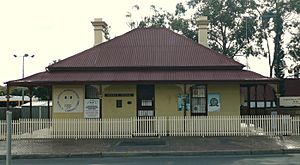Dredges Cottage facts for kids
Quick facts for kids Dredges Cottage |
|
|---|---|

Dredges Cottage, pictured in 2008.
|
|
| Location | 303 Queen Street, Campbelltown, City of Campbelltown, New South Wales, Australia |
| Owner | Campbelltown City Council |
| Official name: Dredges Cottage | |
| Type | State heritage (built) |
| Designated | 2 April 1999 |
| Reference no. | 640 |
| Type | Cottage |
| Category | Residential buildings (private) |
| Lua error in Module:Location_map at line 420: attempt to index field 'wikibase' (a nil value). | |
Dredges Cottage is a very old house in Campbelltown, Australia. It used to be a home but is now an office. This special building is located at 303 Queen Street.
It is owned by the Campbelltown City Council. The cottage is listed on the New South Wales State Heritage Register. This means it is an important historical place that needs to be protected. It was added to the list on 2 April 1999.
Contents
A Look Back at Campbelltown's History
The Early Days of Airds
The area we now know as Campbelltown was once called Airds. Governor Macquarie visited in 1810. He decided to create a new district for settlers there. He named it Airds, honoring his wife Elizabeth's family estate in Scotland.
The name Airds was used a lot at first. But as small villages grew, the name became less common. It was used again in 1975 for a new housing area.
Settling the Land
People from Europe started settling in the Campbelltown area in 1809. This was an alternative to the Hawkesbury district, which often flooded. A road from Sydney to Liverpool began in 1811. It opened in 1814 and was extended to Appin.
This important road passed through Campbelltown. It was first called High Street. Later, in the late 1800s, it was renamed Queen Street.
The Land Grant and William Bradbury
The land where Dredges Cottage stands was given to Joseph Phelps in 1816. He had been farming there for some years. Phelps was one of the local farmers who helped pay for a courthouse in Sydney.
However, Phelps lost his land because he owed money. It was sold in 1817 to William Bradbury. Bradbury paid £100, plus twelve cattle and the crops growing there.
Next to Phelps' land, a surveyor named James Meehan set aside land for a village. In 1820, Governor Macquarie officially declared this land a town. He named it Campbelltown, also in honor of his wife's family.
William Bradbury's Story
William Bradbury (1774-1836) came to Australia in 1812. His daughter, Mary, followed him in 1815. Bradbury later married Catherine Patrick in Campbelltown.
Governor Macquarie visited Campbelltown in 1822. He had breakfast at "Bradbury's," which was an inn. This inn was likely the one later known as the Royal Oak. Macquarie noted that Bradbury was building a good two-story brick house. He named Bradbury's farm "Bradbury Park." This house was considered the best building in Campbelltown in 1826.
Queen Street's Importance
Queen Street was the main street of Campbelltown. One side of the street was outside the official town boundary. But smart business owners soon realized both sides were good for trade. They bought or leased land from those who owned property next to the town.
By the 1840s, many shops and hotels were on the western side of High Street. When the railway arrived in 1858, it also helped make Queen Street the town's main business area.
In the 1960s, a group of old two-story buildings on Queen Street was identified as very special. They were built in the late 1840s and showed a unique style. These buildings were bought by government groups to make sure they would be saved.
Why Dredges Cottage is a Heritage Site
Dredges Cottage is a very important historical building. It was officially listed on the New South Wales State Heritage Register on 2 April 1999. This listing helps protect the cottage for future generations.

